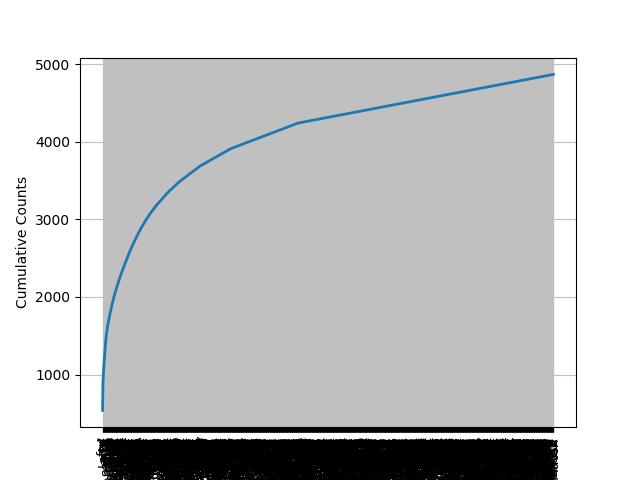NLP(一)语料库和WordNet
原文链接:http://www.one2know.cn/nlp1/
- 访问语料库
NLTK数据库的安装:http://www.nltk.org/data.html
NLTK语料库列表:http://www.nltk.org/nltk_data/
内部访问(以Reuters corpus为例):
import nltk
from nltk.corpus import reuters
# 下载路透社语料库
nltk.download('reuters')
# 查看语料库的内容
files = reuters.fileids()
print(files)
# 访问其中一个文件的内容
words14826 = reuters.words(['test/14826'])
print(words14826[:20])
# 输出主题(一共90个)
reutersGenres = reuters.categories()
print(reutersGenres)
# 访问一个主题,一句话一行输出
for w in reuters.words(categories=['tea']):
print(w + ' ',end='')
if w is '.':
print()
- 下载外部语料库并访问(以影评数据集为例)
下载数据集:http://www.cs.cornell.edu/people/pabo/movie-review-data/
本例下载了1000积极和1000消极的影评
from nltk.corpus import CategorizedPlaintextCorpusReader
# 读取语料库
reader = CategorizedPlaintextCorpusReader(r'D:\PyCharm 5.0.3\WorkSpace\2.NLP\语料库\1.movie_review_data_1000\txt_sentoken',r'.*\.txt',cat_pattern=r'(\w+)/*')
print(reader.categories())
print(reader.fileids())
# 语料库分成两类
posFiles = reader.fileids(categories='pos')
negFiles = reader.fileids(categories='neg')
# 从posFiles或negFiles随机选择一个文件
from random import randint
fileP = posFiles[randint(0,len(posFiles)-1)]
fileN = negFiles[randint(0,len(negFiles)-1)]
# 逐句打印随机的选择文件
for w in reader.words(fileP):
print(w + ' ',end='')
if w is '.':
print()
for w in reader.words(fileN):
print(w + ' ',end='')
if w is '.':
print()
CategorizedPlaintextCorpusReader类通过参数的设置,从内部将样本加载到合适的位置
- 语料库中的词频计算和计数分布分析
以布朗语料库为例:布朗大学 500个文本 15个类
import nltk
from nltk.corpus import brown
nltk.download('brown')
# 查看brown中的类别
print(brown.categories())
# 挑选出三种类别,并获取其中的疑问词
genres = ['fiction','humor','romance']
whwords = ['what','which','how','why','when','where','who']
# 迭代器分别分析3种类
for i in range(0,len(genres)):
genre = genres[i]
print()
print("Analysing '"+ genre + "' wh words")
genre_text = brown.words(categories = genre)
print(genre_text)
# 返回输入单词对象的wh类及对应的频率
fdist = nltk.FreqDist(genre_text)
for wh in whwords:
print(wh + ':',fdist[wh],end=' ')
print()
输出:
['adventure', 'belles_lettres', 'editorial', 'fiction', 'government', 'hobbies', 'humor', 'learned', 'lore', 'mystery', 'news', 'religion', 'reviews', 'romance', 'science_fiction']
Analysing 'fiction' wh words
['Thirty-three', 'Scotty', 'did', 'not', 'go', 'back', ...]
what: 128 which: 123 how: 54 why: 18 when: 133 where: 76 who: 103
Analysing 'humor' wh words
['It', 'was', 'among', 'these', 'that', 'Hinkle', ...]
what: 36 which: 62 how: 18 why: 9 when: 52 where: 15 who: 48
Analysing 'romance' wh words
['They', 'neither', 'liked', 'nor', 'disliked', 'the', ...]
what: 121 which: 104 how: 60 why: 34 when: 126 where: 54 who: 89
- 网络文本和聊天文本的词频分布
import nltk
from nltk.corpus import webtext
# nltk.download('webtext')
print(webtext.fileids())
# 选择一个数据文件,并计算频率分布,获得FreqDist的对象fdist
fileid = 'singles.txt' # 个人广告
wbt_words = webtext.words(fileid)
fdist = nltk.FreqDist(wbt_words)
# 获取高频单词及其计数
print('最多出现的词 "' , fdist.max() , '" :' , fdist[fdist.max()])
# 获取所有单词的计数
print(fdist.N())
# 找出最常见的10个词
print(fdist.most_common(10))
# 将单词和频率制成表格
print(fdist.tabulate(5))
# 将单词和频率制成分布图
fdist.plot(cumulative=True) # 计数显示,cumulative=percents为百分比显示
输出:
['firefox.txt', 'grail.txt', 'overheard.txt', 'pirates.txt', 'singles.txt', 'wine.txt']
最多出现的词 " , " : 539
4867
[(',', 539), ('.', 353), ('/', 110), ('for', 99), ('and', 74), ('to', 74), ('lady', 68), ('-', 66), ('seeks', 60), ('a', 52)]
, . / for and
539 353 110 99 74
None
累计计数分布图:

- 使用WordNet获取一个词的不同含义
# import nltk
# nltk.download('wordnet')
from nltk.corpus import wordnet as wn
chair = 'chair'
# 输出chair的各种含义
chair_synsets = wn.synsets(chair)
print('Chair的意思:',chair_synsets,'\n\n')
# 迭代输出 含义,含义的定义,同义词条,例句
for synset in chair_synsets:
print(synset,': ')
print('Definition: ',synset.definition())
print('Lemmas/Synonymous words: ',synset.lemma_names())
print('Example: ',synset.examples(),'\n')
输出:
Chair的意思: [Synset('chair.n.01'), Synset('professorship.n.01'), Synset('president.n.04'), Synset('electric_chair.n.01'), Synset('chair.n.05'), Synset('chair.v.01'), Synset('moderate.v.01')]
Synset('chair.n.01') :
Definition: a seat for one person, with a support for the back
Lemmas/Synonymous words: ['chair']
Example: ['he put his coat over the back of the chair and sat down']
Synset('professorship.n.01') :
Definition: the position of professor
Lemmas/Synonymous words: ['professorship', 'chair']
Example: ['he was awarded an endowed chair in economics']
Synset('president.n.04') :
Definition: the officer who presides at the meetings of an organization
Lemmas/Synonymous words: ['president', 'chairman', 'chairwoman', 'chair', 'chairperson']
Example: ['address your remarks to the chairperson']
Synset('electric_chair.n.01') :
Definition: an instrument of execution by electrocution; resembles an ordinary seat for one person
Lemmas/Synonymous words: ['electric_chair', 'chair', 'death_chair', 'hot_seat']
Example: ['the murderer was sentenced to die in the chair']
Synset('chair.n.05') :
Definition: a particular seat in an orchestra
Lemmas/Synonymous words: ['chair']
Example: ['he is second chair violin']
Synset('chair.v.01') :
Definition: act or preside as chair, as of an academic department in a university
Lemmas/Synonymous words: ['chair', 'chairman']
Example: ['She chaired the department for many years']
Synset('moderate.v.01') :
Definition: preside over
Lemmas/Synonymous words: ['moderate', 'chair', 'lead']
Example: ['John moderated the discussion']
- 上位词和下位词
下位词更具体,上位词更一般(泛化)
以bed.n.01和woman.n.01为例:
from nltk.corpus import wordnet as wn
woman = wn.synset('woman.n.01')
bed = wn.synset('bed.n.01')
# 返回据有直系关系的同义词集,上位词!
print(woman.hypernyms())
woman_paths = woman.hypernym_paths()
# 打印从根节点到woman.n.01的所有路径
for idx,path in enumerate(woman_paths):
print('\n\nHypernym Path :',idx+1)
for synset in path:
print(synset.name(),',',end='')
# 更具体的术语,下位词!
types_of_bed = bed.hyponyms()
print('\n\nTypes of beds(Hyponyms): ',types_of_bed)
# 打印出更有意义的lemma(词条)
print('\n',sorted(set(lemma.name() for synset in types_of_bed for lemma in synset.lemmas())))
输出:
[Synset('adult.n.01'), Synset('female.n.02')]
Hypernym Path : 1
entity.n.01 ,physical_entity.n.01 ,causal_agent.n.01 ,person.n.01 ,adult.n.01 ,woman.n.01 ,
Hypernym Path : 2
entity.n.01 ,physical_entity.n.01 ,object.n.01 ,whole.n.02 ,living_thing.n.01 ,organism.n.01 ,person.n.01 ,adult.n.01 ,woman.n.01 ,
Hypernym Path : 3
entity.n.01 ,physical_entity.n.01 ,causal_agent.n.01 ,person.n.01 ,female.n.02 ,woman.n.01 ,
Hypernym Path : 4
entity.n.01 ,physical_entity.n.01 ,object.n.01 ,whole.n.02 ,living_thing.n.01 ,organism.n.01 ,person.n.01 ,female.n.02 ,woman.n.01 ,
Types of beds(Hyponyms): [Synset('berth.n.03'), Synset('built-in_bed.n.01'), Synset('bunk.n.03'), Synset('bunk_bed.n.01'), Synset('cot.n.03'), Synset('couch.n.03'), Synset('deathbed.n.02'), Synset('double_bed.n.01'), Synset('four-poster.n.01'), Synset('hammock.n.02'), Synset('marriage_bed.n.01'), Synset('murphy_bed.n.01'), Synset('plank-bed.n.01'), Synset('platform_bed.n.01'), Synset('sickbed.n.01'), Synset('single_bed.n.01'), Synset('sleigh_bed.n.01'), Synset('trundle_bed.n.01'), Synset('twin_bed.n.01'), Synset('water_bed.n.01')]
['Murphy_bed', 'berth', 'built-in_bed', 'built_in_bed', 'bunk', 'bunk_bed', 'camp_bed', 'cot', 'couch', 'deathbed', 'double_bed', 'four-poster', 'hammock', 'marriage_bed', 'plank-bed', 'platform_bed', 'sack', 'sickbed', 'single_bed', 'sleigh_bed', 'truckle', 'truckle_bed', 'trundle', 'trundle_bed', 'twin_bed', 'water_bed']
- 基于WordNet计算某种词性的多义性
以名词n为例:
from nltk.corpus import wordnet as wn
type = 'n' #动词v,副词r,形容词a
# 返回WordNet中所有type类型的同义词集
sysnets = wn.all_synsets(type)
# 将所有词条合并成一个大list
lemmas = []
for sysnet in sysnets:
for lemma in sysnet.lemmas():
lemmas.append(lemma.name())
# 删除重复词条,list=>set
lemmas = set(lemmas)
# 计算每个词条type类型的含义数并加到一起
count = 0
for lemma in lemmas:
count = count + len(wn.synsets(lemma,type)) # lemma在type类型下的所有含义
# 打印所有数值
print('%s总词条数: '%(type),len(lemmas))
print('%s总含义数: '%(type),count)
print('%s平均多义性: '%(type),count/len(lemmas))
输出:
n总词条数: 119034
n总含义数: 152763
n平均多义性: 1.2833560159282222
NLP(一)语料库和WordNet的更多相关文章
- nltk安装及wordnet使用详解
环境:python2.7.10 首先安装pip 在https://pip.pypa.io/en/stable/installing/ 下载get-pip.py 然后执行 python get-pip. ...
- 自然语言处理--nltk安装及wordnet使用详解
环境:python2.7.10 首先安装pip 在https://pip.pypa.io/en/stable/installing/ 下载get-pip.py 然后执行 python get-pip. ...
- 【NLP】大数据之行,始于足下:谈谈语料库知多少
大数据之行,始于足下:谈谈语料库知多少 作者:白宁超 2016年7月20日13:47:51 摘要:大数据发展的基石就是数据量的指数增加,无论是数据挖掘.文本处理.自然语言处理还是机器模型的构建,大多都 ...
- NLP语料库
文本语料库是一个大型结构化文本的集合 NLTK包含了许多语料库: (1)古滕堡语料库 (2)网络和聊天文本 (3)布朗语料库 (4)路透社语料库 (5)就职演讲语料库 (6)标注文本语料库 词汇列表 ...
- NLP—WordNet——词与词之间的最小距离
WordNet,是由Princeton 大学的心理学家,语言学家和计算机工程师联合设计的一种基于认知语言学的英语词典.它不是光把单词以字母顺序排列,而且按照单词的意义组成一个“单词的网络”.我们这次的 ...
- lecture1-Word2vec实战班-七月在线nlp
nltk的全称是natural language toolkit,是一套基于python的自然语言处理工具集.自带语料库.词性分类库.自带分类分词等功能.强大社区支持.很多简单版wrapper 文本处 ...
- (Stanford CS224d) Deep Learning and NLP课程笔记(二):word2vec
本节课将开始学习Deep NLP的基础--词向量模型. 背景 word vector是一种在计算机中表达word meaning的方式.在Webster词典中,关于meaning有三种定义: the ...
- NLP十大里程碑
NLP十大里程碑 2.1 里程碑一:1985复杂特征集 复杂特征集(complex feature set)又叫做多重属性(multiple features)描写.语言学里,这种描写方法最早出现在语 ...
- 利用Tensorflow进行自然语言处理(NLP)系列之一Word2Vec
同步笔者CSDN博客(https://blog.csdn.net/qq_37608890/article/details/81513882). 一.概述 本文将要讨论NLP的一个重要话题:Word2V ...
随机推荐
- IrisSkin2.dll 添加皮肤
使用说明:把控件拖到你的form上,只需一行代码,即可实现整个form包括其所有控件的皮肤的更换,总共有几十套皮肤供使用,非常方便.省去你设计开发软件皮肤系统的时间和精力.全部源代码就一行: skin ...
- 【iOS】libc++abi.dylib: terminate_handler unexpectedly threw an exception
用 ShareSDK 做第三方分享的时候遇到了这个问题…… 联系了客服,后来在他的指导下,发现是数组的问题,该问题不知道是否具有通用性,暂且记下.
- vue动态表单
项目需求,需要根据后台接口返回数据,动态添加表单内容 说明:此组件基于Ant Design of Vue 目前支持六种表单控件:文本输入框(TextInput).文本域输入框(TextArea).下拉 ...
- Unity基于NGUI的简单并可直接使用的虚拟摇杆实现(一)
可能大家都听说过大名鼎鼎的easytouch,然而easytouch是基于UGUI的,两种不同的UI混用,可能会造成项目管理的混乱,并且可能会出现各种幺蛾子,比如事件传递互相扰乱的问题. 于是就想找一 ...
- opencv图像直方图均衡化及其原理
直方图均衡化是什么有什么用 先说什么是直方图均衡化,通俗的说,以灰度图为例,原图的某一个像素为x,经过某个函数变为y.形成新的图.新的图的灰度值的分布是均匀的,这个过程就叫直方图均衡化. 图像直方图均 ...
- LR(1)语法分析器生成器(生成Action表和Goto表)java实现(二)
本来这次想好好写一下博客的...结果耐心有限,又想着烂尾总比断更好些.于是还是把后续代码贴上.不过后续代码是继续贴在BNF容器里面的...可能会显得有些臃肿.但目前管不了那么多了.先贴上来吧hhh.说 ...
- JS中map()与forEach()的区别和用法
相同点: 1.都是循环遍历数组中的每一项 2.每次执行匿名函数都支持三个参数,参数分别为item(当前每一项),index(索引值),arr(原数组) 3.匿名函数中的this都是指向window 4 ...
- koa2图片上传成功后返回服务器地址,实时显示服务器图片
版本:node(8.5.0); koa(2.4.1); koa-router(7.3.0); koa-body(2.5.0); koa-static(4.0.2); 代码实现 const fs = r ...
- 调用百度翻译 API 来翻译网站信息
之前说过jquery.i18n.js 来做网站的中英翻译,前提就得做一套中文内容,一套英文内容来解决,好处是中英翻译可以准确无误,本篇文章我们来看一下调用百度翻译的 API 来进行网站的翻译,但是翻译 ...
- 100天搞定机器学习|Day36用有趣的方式解释梯度下降算法
本文为3Blue1Brown神经网络课程讲解第二部分<Gradient descent, how neural networks learn >的学习笔记,观看地址:www.bilibil ...
